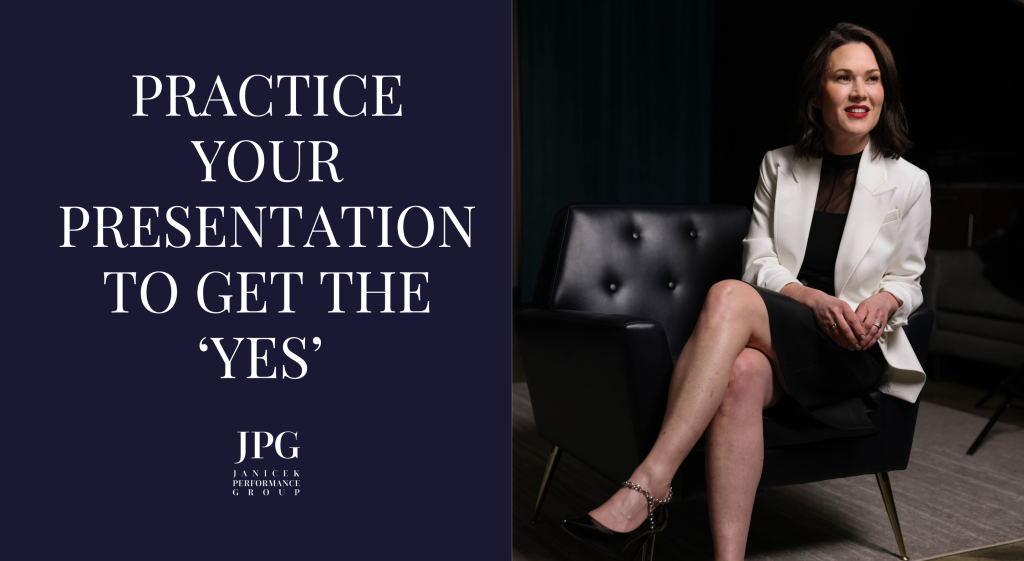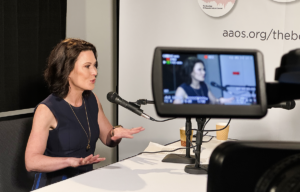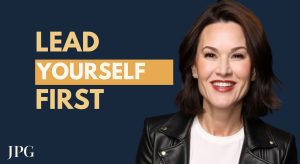The Question That Changes Everything About Public Speaking
I was coaching 25 executives from a Fortune 500 company last week when someone asked a question that stopped me cold:
“Can you overprepare for a presentation? I like to wing it because then I feel great energy and I know I’m awesome when I wing it.”
Here’s what I told them:
That energy you feel when you wing it? It’s not confidence. It’s adrenaline masking anxiety.
Real confidence comes from business presentation preparation so thorough that you can handle anything the room throws at you.
Why Great Presentations Rely More on Prep Than Talent
At Janicek Performance Group, we have a rule: You must prepare so you can play.
This isn’t about killing spontaneity, removing personality, or turning you into a corporate robot. It’s about building a foundation so strong that when the unexpected happens in your business meeting, you’re ready for it.
If your public speaking skills can capture someone’s interest straight away, there’s a good chance they’ll listen to the rest of the presentation. That capture happens through preparation, not improvisation.
Let me share a story that proves this point.
The $10 Million Business Presentation That Changed Everything
We worked with the president of a major organization who needed to go before his board and ask for $10 million in additional funding.
Ten. Million. Dollars.
The stakes couldn’t have been higher.
We spent 20 hours together, both on Zoom and in person. We practiced his 12-minute pitch until he could deliver it in his sleep. We anticipated every possible question, every potential objection, every way the conversation could unfold.
When he walked into that boardroom, something magical happened.
He delivered his presentation with such clarity and conviction that the board didn’t hesitate. They didn’t need time to think it over or discuss it among themselves.
“Thank you. Absolutely. You’ve got the money.”
His text to me afterward was simple: “I got it. I got the money.”
That’s the power of strategic presentation preparation.
Why ‘Winging It’ Is Sabotaging Your Executive Presence
When you wing business presentations, you’re gambling with your reputation, your message, and your results.
Sure, sometimes you get lucky. Sometimes the adrenaline kicks in and you deliver something decent.
Sometimes.
Here’s what happens more often when you don’t prepare for presentations.
- You ramble instead of delivering clear, focused messages that drive action.
- You miss key points that could have sealed the deal or secured the promotion.
- You stumble when faced with unexpected questions from stakeholders.
- You leave the room feeling like you could have done better.
- Your audience walks away unsure of your main message or next steps.
- You lose credibility with senior leadership and key decision-makers.
The executives who consistently get “yes” responses don’t rely on luck or natural charisma. They prepare strategically.
How to Prepare for a Business Presentation: 7 Essential Steps
Effective presentation preparation isn’t about memorizing a script word-for-word. It’s about building competence and confidence through deliberate practice.
Here’s how the most successful business leaders prepare for high-stakes presentations.
1. Define Your Core Message and Call to Action
Write your key message as a single sentence. Everything else in your presentation should support this central idea.
Can you explain your main point in 30 seconds? Two minutes? 12 minutes? Your presentation should tell a persuasive story, establish your business expertise, address any concerns of customers, clients, investors, or partners, and end with a call for action.
2. Create Audience Profiles For Key Decision-Makers Who Will Be Present
Before you create a single slide, understand who’s in the room.
- What are their priorities and pain points?
- What level of detail do they need?
- What objections might they have?
- What does success look like from their perspective?
3. Structure Your Presentation for Maximum Impact
Great presentations require you to frame your story — figure out where to start and where to end.
Your business presentation should follow a logical flow.
- Opening Hook: Start with a compelling story, statistic, or question.
- Problem/Opportunity: Define what needs to be addressed.
- Solution: Present your recommendations with supporting evidence.
- Benefits: Clearly articulate the value and ROI.
- Next Steps: End with specific, actionable requests.
4. Anticipate Questions and Prepare Thoughtful Responses
List five potential questions and practice your responses. Focus on bridging back to your core message.
You should also prepare answers for the challenging questions that will inevitably come up. Successful executives don’t just prepare their main presentation, they prepare for the conversation that follows.
5. Practice Your Delivery Until It Feels Natural
Plan your delivery. Develop bullet points and then rehearse it, out loud, over and over.
Practice Methods That Work.
- Record yourself and review for clarity and pacing.
- Present to colleagues who will give honest feedback.
- Practice in the actual room or similar space if possible.
- Rehearse with the technology you’ll be using.
6. Prepare for the Unexpected
What if the projector fails? What if you only get half your allotted time? What if the CEO joins unexpectedly? Professional speakers always have contingency plans.
Backup Strategies.
- Create a “no slides” version of your presentation.
- Prepare five-minute, 15-minute, and 30-minute versions.
- Bring printed handouts as backup.
- Have your key points memorized, not just scripted.
7. Focus on Your Opening and Closing
Start your presentation with a small story or anecdote about your business. Use something that captures curiosity. Your first 30 seconds determine whether people listen or mentally check out.
Your closing should be equally powerful. Summarize your key points and make your ask or point crystal clear.
The ROI of Thorough Presentation Preparation
That $10 million presentation wasn’t just about securing funding. It was about a leader who showed up so prepared, so confident, and so compelling that his board had no choice but to say yes.
Think about your last important business presentation. How did it go? Did you get the outcome you wanted?
Now imagine walking into every high-stakes situation knowing you’ve done the work. Knowing you’re ready for whatever comes your way.
That’s what strategic preparation gives you: the confidence to get more “yes” responses because you’ve earned them through thorough planning and practice.
Your Next Step: Stop Winging It, Start Winning It
The question isn’t whether you should prepare for your next important business presentation.
The question is: How thoroughly will you prepare?
Because here’s the truth: Your competition is preparing. Your colleagues are preparing. The leaders getting promoted and closing deals are preparing with intention and strategy.
When you show up thoroughly prepared, people notice. They lean in. They say yes more often.
Don’t you want to be so prepared that people just say yes to you more often?
Don’t we all want that?
Ready to Transform Your Presentation Skills?
Every business presentation is an opportunity to advance your career, secure resources, or drive important change.
The executives who consistently succeed don’t leave these moments to chance. They prepare strategically, practice deliberately, and show up ready to win.
At JPG, we specialize in training leaders to accelerate growth, command attention, and drive innovation through impactful communication. If you’re ready to transform your presentations from wing-it moments to win-it moments, reach out today to learn how we can help you prepare to play at the highest level.





